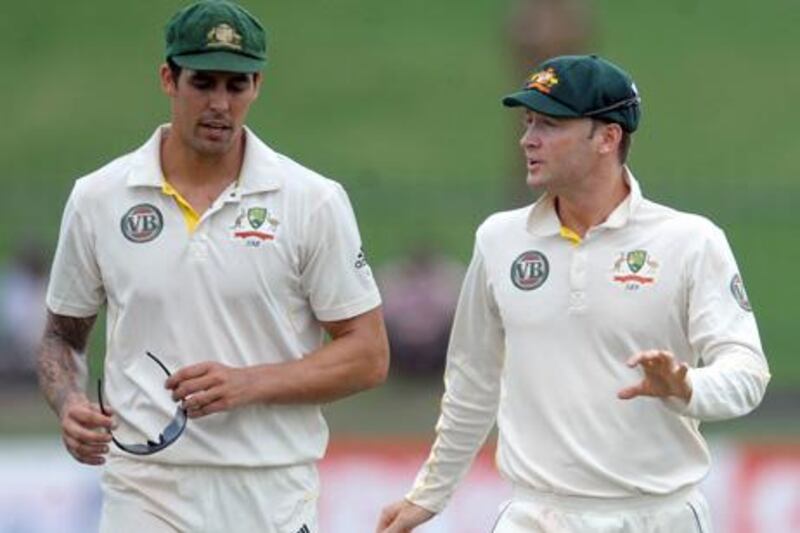As a fast bowler, few diagnoses can be worse than when Mike Selvey, the former England bowler and current Guardian cricket correspondent, concludes your career may be over.
Last week, as news emerged that Mitchell Johnson would undergo surgery on a toe injury that is likely to keep him out for six months, Selvey ended an article, actually on Patrick Cummins, thus: "We may have seen the last of Mitchell Johnson."
There are few sharper observers of the behavioural disorder that is fast bowling than Selvey and fewer still who are able to articulate the unique physicality of its requirements and of the minute details that can go wrong in its pursuit as well as he. So if he feels, sensitively as ever, that we have seen the last of Johnson, it is worth taking notice.
If so, then it will be difficult to make sense of such a baffling, incomplete career, and a short one; he only made his Test debut four years ago.
Over 47 Tests, he went from being the new face of an Australia in transition, the leader of their attack, to the emblem of an Australia in decline, a first-change misfit. What went so wrong with him from the 2009 Ashes that it seemed some light inside him had been abruptly switched off thereafter?
No doubt there is a technical dissection to be done. That left arm has always looked a little too low but unorthodoxy has never held the modern cricketer back; else there would be no Lasith Malinga.
The wrist is a likelier culprit. Waqar Younis feels, for example, a loose wrist may enslave Wahab Riaz to exactly the kind of inconsistencies, in lines particularly, that afflict Johnson.
Then, of course, there is his famous inability to "bring the ball back in" to right-handed batsmen. Cricket has become especially unforgiving these days of any left-arm paceman without this skill.
Some time ago, a prominent former Australia captain witheringly put down Johnson, wondering how any right-handed batsmen could give his wicket away to him when every ball was slanting across him so leg-before and bowled were out of the question.
So hung is cricket on this that after a while, the ability to swing the ball back in seemed to be the only plank on which the career of Irfan Pathan - and countless others - existed. You might as well bowl with the other arm if you cannot do that.
Johnson could and did do it, but only occasionally early in his career and famously only once in Perth in the last Ashes.
And if it does not come naturally, it is not an easy skill to develop. It took Wasim Akram, the greatest left-arm paceman, long and difficult hours in the nets to get it right. Even then he would, for periods, lose it entirely.
To others, like Mohammad Amir, another left-arm fast bowler, it seemed to have been handed out in some secret room in the maternity ward.
But these two - and Zaheer Khan now - provide a more revealing point of reference. It is not just this ability that has propelled them - or the inability thereof that has held Johnson back. Akram and Zaheer -and even Amir so early in his career - seemed so much more complete and had so much more to offer than just the variation of one that swings in.
Johnson seems to have possessed little of their guile, their astuteness in working out batsmen and figuring out what works best on different pitches, in different match situations.
Sure his pace, and more impressively the ability to sustain it, stood him apart from many others: not many bowlers, with such little outward effort, maintained speeds at 145kph over longish spells. But too often over the last two years he was a bowler of just two lengths (short and full) and many, many lines.
Coming around the wicket did not make him any more threatening. There was no real exploration of angles around the crease, or even the temporary and periodic reinventions many fast bowlers go through (Akram had to relearn using the new ball after he became too reliant on the old for reverse swing).
He has not grown as James Anderson and Dale Steyn have, for example, beyond being capable only of the occasional magic ball.
In his last Test, Johnson looked as he did in his first (though such was his confusion he was bowling off a shorter run now).
None of these are creases for which there aren't any prescriptions so perhaps answers were to be found in his head.
Studded and tattooed, he looked like someone auditioning for the part of snarling Australian fast bowler, not the chosen one. The eyes always held too much self-doubt, the same way Mohammad Sami never looked comfortable.
It is not inconceivable that he returns. Newer, younger fast bowlers are blooming but a series against India's batsmen these days (the 2011 summer excepted) can be a bruising formative experience.
But if he doesn't, then he represents a prick to the idea, embedded in the subcontinent especially, that all talent needs is good care and administration.
There is no better place, we've thought all these years, than Australia to be nurtured as a cricketer, to grow and develop under stable, sensible handling. Cricketers are not just born there, they are bred. Johnson had all this. He cannot complain of unjust, callous treatment. But sometimes even the truest talent - and if Selvey pronounced it extinguished, then no less a judge than Dennis Lillee had announced its emergence over a decade ago - does not work out.
It is not because of anything other than that, as we forget, often it just is not meant to be.





